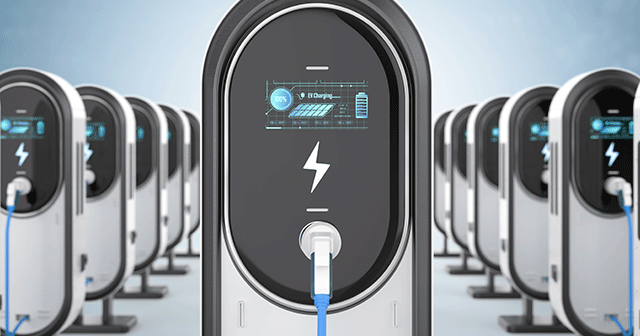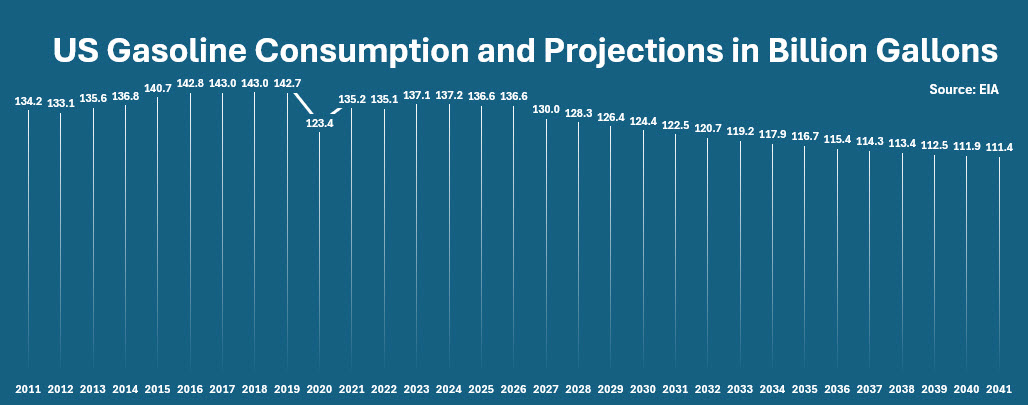Taking Stock of the EV Movement

This article was originally published in Independent Gasoline Marketing, a bi-monthly magazine by SIGMA.
Gasoline consumption in the United States likely peaked in 2018 despite an ongoing increase in vehicle miles traveled on U.S. roadways, which grew 2.1% year-on-year in 2023, according to the Federal Highway Administration. A combination of improving vehicle efficiency and electric vehicle sales is tamping down gasoline consumption despite population growth. Meanwhile tightening environmental regulations and federal tax incentives teaming up to safeguard the trend.
In 2020, around one in 25 cars sold worldwide were electric; in 2023, it was one in five. EVs are now at the heart of most automakers’ strategies for the future.
“Together with rapidly increasing investment into battery manufacturing, this makes a U-turn away from [EVs] improbable and impractical,” said Fatih Birol, executive director at the International Energy Agency, in late March.

“Gasoline consumption in the U.S. likely peaked in 2018 despite an ongoing increase in vehicle miles traveled on U.S. roadways.”
Four days prior (March 20), the U.S. Environmental Protection Agency released its final rule for “Multi-Pollutant Emissions Standards for Model Years 2027 and Later Light-Duty and Medium-Duty Vehicles” that accelerates the trend to EVs. In the early years of the rule, the agency charts a more gradual transition to EVs by including plug-in hybrid electric vehicles in its classification of EVs, which use both gasoline and battery-generated electricity to power a vehicle. In its rule, EPA cited analysis of the effect the Bipartisan Infrastructure Law and Inflation Reduction Act would have on market penetration of PEVs.
“Researchers from Harvard University, MIT, and Cornell University examined the effects of subsidies and tax incentives provided by the BIL and the IRA to promote plug-in electric vehicle sales and the deployment of charging infrastructure. This study predicted plug-in electric vehicle sales shares of 55% to 58% in 2030 when both sales and infrastructure subsidies and incentives were considered,” said EPA.
Analysis by the U.S. Department of Energy’s Office of Policy projected zero emissions light-duty vehicle sales would account for 49% to 65% of new vehicle sales by 2030 while the IEA estimates a 50% market share. Bloomberg’s EV Outlook for 2023 projected a nearly 28% share of passenger PEVs by 2026.
“[A]s the EPA greenhouse gas standards have increased in stringency, automakers have relied to a greater degree on a range of electrification technologies, including idle stop-start, mild hybrid electric vehicles with a belt integrated starter-generator, hybrid electric vehicles (HEVs) and, in recent years, plug-in electric vehicles (PEVs), which include plug-in hybrid electric vehicles (PHEVs) and battery-electric vehicles (BEVs),” said EPA.
“Q1 2024 has shown a 4.5% increase in year-over-year sales. Hybrids are the trend that consumers are wanting,” according to Good Car Bad Car. Hybrids capture the “reliability and familiarity of gas power [and] fuel savings of electric power.”
Edmunds, which provides consumers advice on vehicle purchases, notes EV sales rose to a 6.9% new vehicle market share in 2023 from 5.2% in 2022, but projects a slower uptake in 2024, predicting EV sales will account for an 8% market share this year. A 2024 Edmunds EV Sentiment Survey highlights the challenge in moving to EV with the primary obstacle to greater EV sales penetration being cost.
“…the primary obstacle to greater EV sales: cost.”
Edmunds found 47% of consumers considering an EV are seeking a purchase price below $40,000; 22% of which desire an EV with a retail price under $30,000. Edmunds notes there are no EVs with a manufacturer’s suggested retail price below $30,000, and only four models priced less than $40,000.
Edmunds said its data shows the average transaction price for an EV in 2023 was $61,702 which compared against all other vehicles with an average purchase price of $47,450.
Consumers most willing to purchase an EV are likely least able to afford an EV, finds the study, noting 90% of 18- to 24-year-olds would consider an EV and 83% of those aged 24 to 34. Among existing vehicle owners, those with pickup trucks are least likely to consider an EV.
The slower transition to EVs has a more gradual effect on gasoline consumption. During model year 2027, when the rule takes effect, EPA estimates a 0.05% reduction in gasoline consumption against the Energy Information Administration’s baseline projections found in EIA’s 2023 Annual Energy Outlook. The reduction is estimated at 0.37% for 2028, 1.11% for 2029, 2.33% in 2030, 3.92% in 2031, and 5.72% in 2032.

Of course, lost demand has a cost for the gasoline industry. EPA puts the pretax loss factored at the retail level at $40.84 billion over the 2027-2032 six-year period.
Consumers’ savings on their gasoline purchases could trigger the rebound effect and drive more, said EPA, with increased travel producing both social and economic opportunities.
The “rebound effect might occur when an increase in vehicle efficiency makes it possible for people to choose to drive more without spending more because of the lower cost per mile of driving,” said EPA. “Additional driving can lead to costs and benefits that can be monetized.”
This is called the “drive value benefit.” EPA estimates that over the six-year period from 2027 to 2032, the drive value benefit is $605 million.
“The economic value of the increased owner/operator surplus provided by additional driving is estimated as one half of the product of the fuel savings per mile and rebound miles,” said EPA, noting the fuel savings will differ among vehicles.
Leaving aside increased costs for electricity consumption, not to mention the viability of an aged and strained national power grid that has already led to blackouts in large population centers, are other costs lurking?
“Under the final standards, there is a small change projected in total new [light-duty] vehicle sales compared to sales under the No Action scenario for each year under from MY 2027 through MY 2032,” explains EPA.

Both the American Petroleum Institute and American Fuel and Petrochemical Manufacturers trade organizations strongly disagree.
“This regulation will make new gas-powered vehicles unavailable or prohibitively expensive for most Americans.”
“This regulation will make new gas-powered vehicles unavailable or prohibitively expensive for most Americans,” said API President and CEO Mike Sommers and AFPM President and CEO Chet Thompson. “For them, this wildly unpopular policy is going to feel and function like a ban.”
By 2032, they note the fleetwide average tailpipe emissions standard will be 85 grams per mile. They explain currently only EVs, and five PHEVs meet the standard.
“This standard is designed to force electric vehicle (EV) adoption and have EVs account for the majority of new car sales by 2030,” said Sommers and Thompson.
When considering costs, EPA does not calculate the loss of freedom of choice.
“EVs still struggle to captivate the mainstream market,” Edmunds found in its survey, noting “new technologies typically undergo a gradual acceptance curve before more than just early adopters jump in.”











 Comprehensive weather insights help safeguard your operations and drive confident decisions to make everyday mining operations as safe and efficient as possible.
Comprehensive weather insights help safeguard your operations and drive confident decisions to make everyday mining operations as safe and efficient as possible.